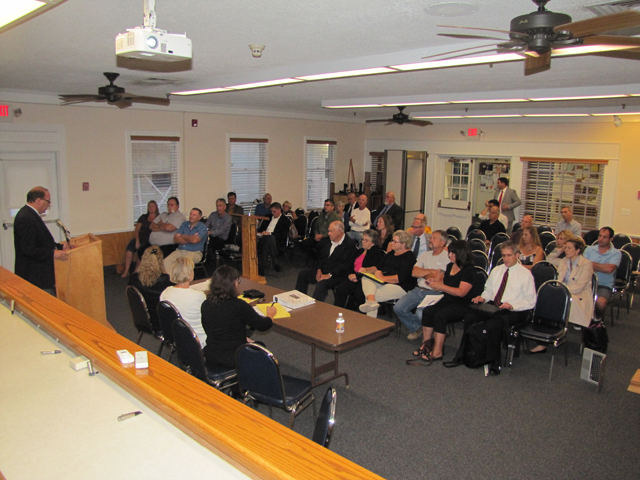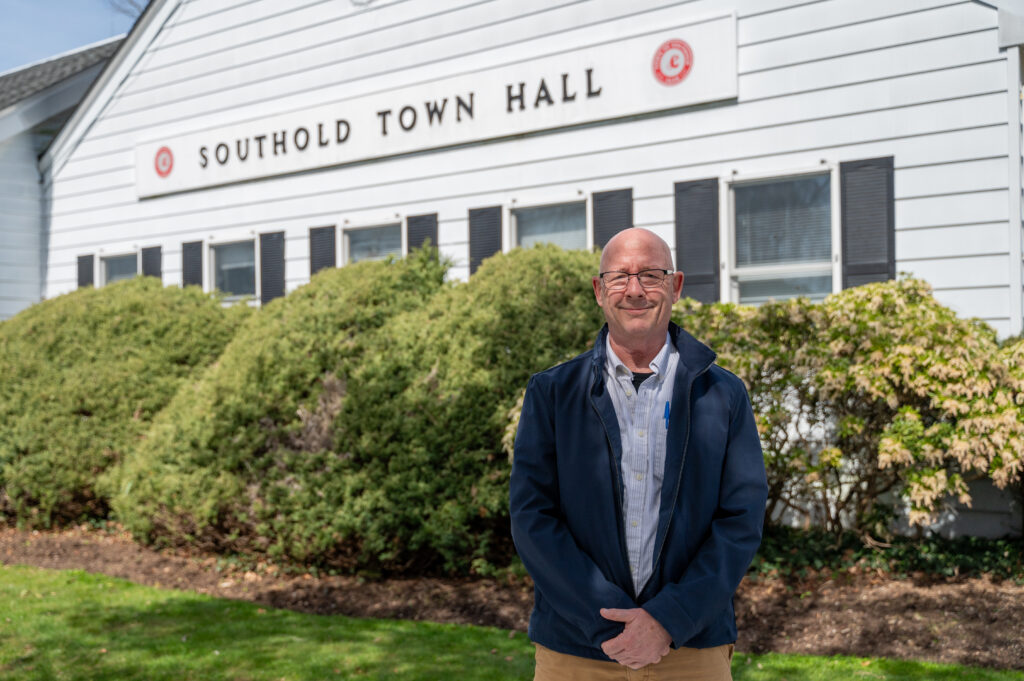Hashamomuck Cove project draws questions about sea level rise


Some Southold Town residents are questioning if the proposed $17.7 million beach re-nourishment project for Hashamomuck Cove will be worth it if sea levels rise.
To restore the beach, residents would also like to know if the U.S. Army Corps of Engineers (ACOE) will use sand dredged from Long Island Sound instead of trucking it in from a sand mine.
In addition, residents are asking for information on how a series of groins built in the water have impacted erosion.
Those were some concerns raised at a public meeting Monday night at Southold Town Hall to discuss the proposed project, which includes creating three berms along the roughly 1.6 mile of coves in the Hashamomuck area and to fill them with about 160,000 cubic yards of sand.
“There’s a little smoke and mirrors here,” said Doug Hardy of Southold, a retired marine science professor. “This is not a solution to the problem as long as sea levels continue to rise. The best and most recent science says that sea levels are accelerated.”
He said property owners in the cove “committed themselves to a poor real estate decision and want the taxpayers to bail them out.”
“If people look at the projected sea level rises in the next 50 to 100 years,” he continued, “you should be frightened. It threatens to separate Greenport from Southold.”
Erosion and flooding in that area also threatens additional properties and roadways, engineers have said. ACOE estimates that $32 million worth of property damage will take place over 50 years if the project is not completed.
When asked about raising Route 48 and Route 25 as a solution, ACOE representative Gene Brickman said such a project will cost far more than restoring the beach.
Kevin McAllister of Defend H2O, an environmental protection group, said the state Department of Environmental Conservation had made sea level projections based on low, medium and high models and asked which one was used in the ACOE study.
DEC representative Sue McCormick said the stats were based on the low-end estimates.
Mr. Brickman said several solutions were considered, including bulkhead construction, before it was determined that restoring the beach would be the most effective method.
“It’s vitally important to keep this moving,” he said. “What can you do today to move this along? You can be supportive. That’s the number one thing. Not to lose momentum.”
The $17.7 million project must have a non-federal sponsor to pay 35 percent of the construction costs. That co-sponsor has yet to be determined, with the state or county as possibilities, as town officials have said they don’t have the money.
Because it uses federal money, the ACOE plan will require public access points every half mile, which would create three access points in this scenario. Each access area requires at least one parking space.
One access point already determined would be the town beach at the west cove, but the access points to center and eastern coves have not yet been selected. The plan allows for property to be acquired by condemnation, if necessary.
David Corwin of Greenport, who owns a small lot that has mostly washed away, said he suspects his property will be targeted for acquisition as public access.
“I own the piece of property in the center portion of the cove, which is probably the piece of property you’re going to come after to confiscate,” he said. “I don’t know how that’s going to work out. I have no objections to the project, but I don’t want to lose my beach.”
Mr. Corwin said he does have an objection as to why the feasibility study for the project “doesn’t address the big groins that are directing the sand off shore rather than letting it stay on the beach.”
He said the groins built on the western part of the cove in the late 1960s “severely increased the erosion rate in the central section east of the groins. The groins are now directing the flow of sand out into the deep water, where it was lost.”
Mr. Brickman said, “groins work, if they are designed and engineered properly.”
Lynn Laskos, a Hashamomuck Cove property owner whose home was knocked off its foundation and into the Long Island Sound in a 1994 storm, thanked the officials present Monday.
She also implored Southold Town to consider being a local sponsor of the project.
“County Road 48 is everybody’s road and if it gets washed out, your cutting off the East End,” she said.
The non-federal sponsor for the project must be in place by July 2017. Congress also must vote to allocate construction funding before the job can begin, Mr. Brickman.
Residents can submit their comments about the proposal to:
Judith Johnson, project biologist, New England District Corps of Engineers, 696 Virginia Road, Concord, MA 01742-2751
Or via email: [email protected]
The public comment period will be closed Sept. 30.
Photo: A public meeting was held Monday at Southold Town Hall to discuss the Hashamomuck Cove project proposed by the U.S. Army Corps of Engineers. (Credit: Tim Gannon)








